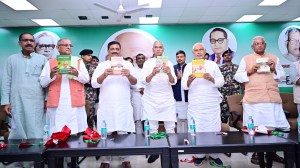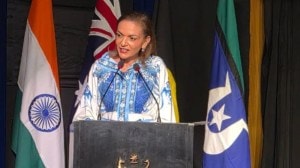All From the President’s Man
P.M. Nair’s account of his years with Kalam paints an affectionate profile of the “people’s president”

The Kalam Effect: My Years with the President
P.M. Nair
Harpercollins india, Rs 295
P.M. Nair’s account of his years with Kalam paints an affectionate profile of the “people’s president”
India’s eleventh president, Abul Pakir Jainulabdeen Abdul Kalam, is not only a fascinating man but also a very lucky man. Before being sworn in as head of state, Kalam’s seven-year tenure as scientific adviser to the defence minister culminated in the Shakti series of nuclear tests in 1998 and a largely successful Integrated Guided Missile Development Programme. It was only after he left that the public and the lawmakers started questioning the Defence Research Development Organisation (DRDO) on cost overruns and delays, and the truth behind its indigenisation of the Indian weapons programme.
In fact, it was the politics of the day and the equation between the then defence minister George Fernandes and Samajwadi Party supremo Mulayam Singh Yadav that prepared the pitch for Kalam as the president of India. His five-year tenure at the Rashtrapati Bhavan was synchronous with the ascent of India to the global high table, with the most powerful people making a beeline for New Delhi. Kalam could even get away with lecturing the high and mighty, including the no-nonsense general Pervez Musharraf of Pakistan, with a presentation on his pet project, Providing Urban Amenities in Rural Areas (PURA).
Of course, none of this is recorded in P.M. Nair’s book The Kalam Effect, which chronicles the career bureaucrat’s five-year term as secretary to President Kalam. The author is unabashed in his praise for Kalam as he nearly believes that his president had a channel to the weather gods. Nair, it seems, has downplayed his own part in the book to show the sharp contrast with Kalam. Like the author himself, the book is rather non-controversial, a narrative of the high point of Nair’s 39-year career in the IAS.
Yet it provides deep insight into the functioning of upright Kalam as president and the seriousness with which he does his job. It also brings out the helplessness of Kalam during the 2005 Bihar Assembly dissolution crisis and the subsequent Supreme Court judgment terming the presidential order as unconstitutional. Although Nair takes it upon himself to advise Kalam to sign the Bihar dissolution in Moscow in the early hours of morning after a hurried Cabinet approval in India and a call from Prime Minister Manmohan Singh, the jury is still out on whether Kalam did the right thing by signing the dissolution right away without taking a considered expert opinion.
Kalam’s instinct otherwise for due diligence is brought out in great detail in the book, especially regarding the Office of Profit Bill as it was returned to the government in the first instance. The chapter on Afzal Guru, one of the main accused in the December 13, 2001, Parliament attack and now on death row, is crisp and informative without being judgmental on the politics of the day.
The author takes us behind the scenes after the 2004 election result and the 2007 presidential elections, only to emphasise that Kalam was above politics.
However, the book is silent on Kalam’s umbilical chord with the defence establishment, particularly the DRDO, even though Nair himself spent nearly a decade in the Defence Ministry. Details of the meeting between Kalam and Kavita Gadgil, whose fighter pilot son Abhijit died in a MiG-21 crash in Rajasthan, would have been fascinating as it was the then president himself who asked for full details from the Indian Air Force. Nair only talks about Kalam’s adventures aboard a Russian Kilo-class submarine, then newly acquired Russian Su-30 MKI fighter and the mandatory Siachen glacier visit.
Nair lavishes praise on Kalam for his simplicity, integrity and sincerity, while at the same time the bureaucrat finds it difficult to adjust to the work routine of the scientist-president. Though there is no overt attempt to profile him, Kalam comes out as a conscientious dreamer who held no malice towards anyone.



- 01
- 02
- 03
- 04
- 05




























